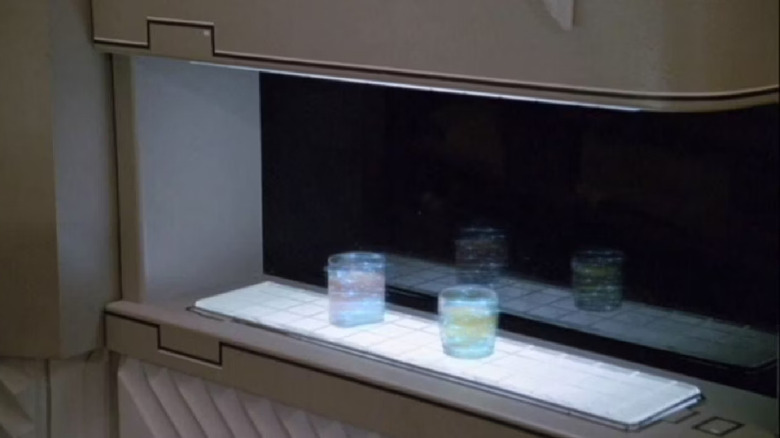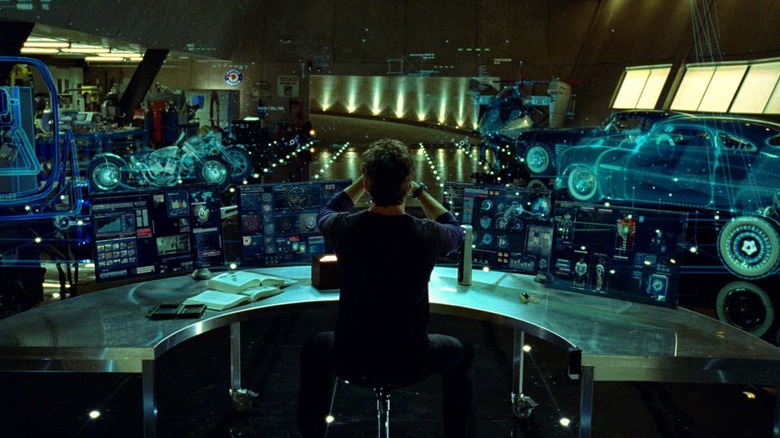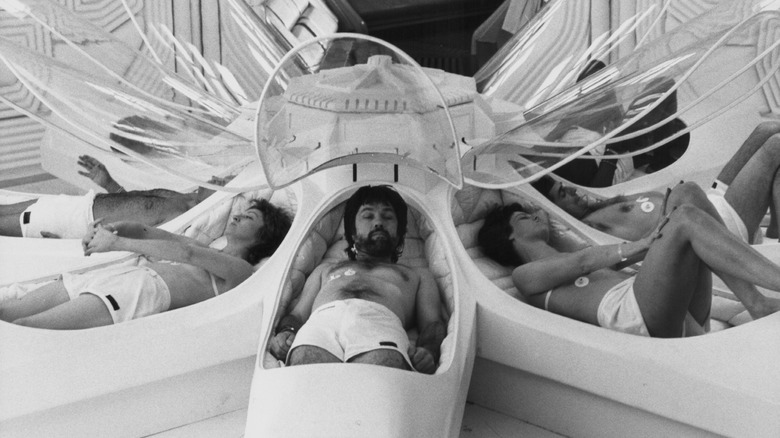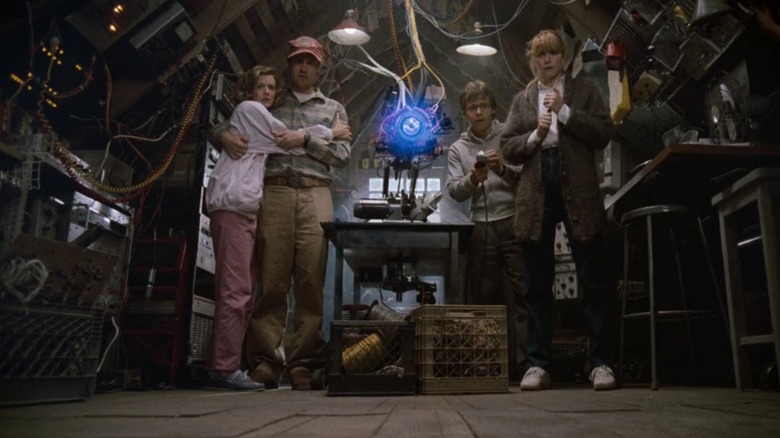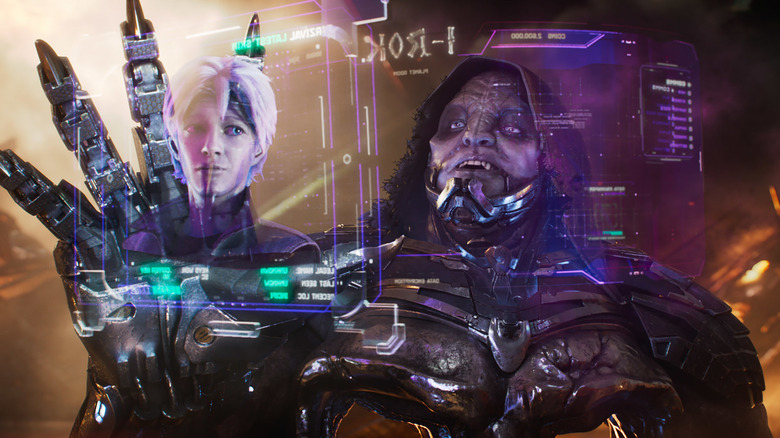5 Pieces Of Movie Tech We Wish Were Real
The world is advancing technology at an exceptional rate. If one were to look back just a couple of decades, they would be impressed to see how far humanity has come. Before smartphones, there were simple cell phones that made it easier to communicate with friends and family around the world, but didn't do much else. Go back a little further and computers used to take up entire rooms. Now, everyone basically has a supercomputer in their pocket. Digital AI assistants are available to help structure a day, and little robots can fill a house to take care of daily tasks like vacuuming.
However, Hollywood has a way of conceiving little sci-fi gadgets that would make life so much easier with every new movie it produces — gadgets that audiences wish were real. Who knows? Many of the tech innovations people think of as something out of sci-fi now might be a reality down the road.
'Star Trek' replicator
The linchpin of a compassionate utopia is abundance for everyone, and the "Star Trek" universe has that in the form of its "replicator." The replicator generates creates and recycles objects on demand. While it's primarily used for food, including the nectar of the gods (coffee), it can also be used to create non-food items like clothes and weapons. Characters from the franchise often make note that the food generated by a replicator doesn't taste as good as the real thing, so there's still motivation to eat actual food, but the technology essentially eliminates world hunger.
It's hard to have a world where people go hungry when you have the technology to duplicate and feed the world for free. Naturally, there would be those in the real world against replicator technology because it would drive down profits in the food industry. The replicator didn't create the utopia that is the "Star Trek" universe, however.
That world had to have compassionate, empathetic people in the majority to create such technology without the urge to capitalize on it. The only way a real-world replicator would come about and be truly beneficial in the same way it is in "Star Trek" is if somebody without a profit-oriented mind developed it. In the meantime, everyone will have to settle for the very few 3D printers that can produce anything edible currently.
Tony Stark's J.A.R.V.I.S. from 'Iron Man'
The world is getting closer and closer to the AI capabilities seen in "Iron Man" and other MCU movies, but the technology as it's depicted in the movie is still lightyears away. Tony Stark's J.A.R.V.I.S. AI assistant makes Alexa and Siri look like toasters in comparison. J.A.R.V.I.S. not only had accurate information to share with Tony, but it also had entire conversations that would presumably pass the Turing test. Having an artificial intelligence assistant like J.A.R.V.I.S. might make people too lazy to do their own research, but then again, there wouldn't be any piece of information they couldn't get.
Furthermore, if Stark's AI came with the operating system that he worked with in the first "Iron Man" movie, where he could grab files and throw them around in a three-dimensional environment, even better. The amount of work and speed with which that work could be conducted would shoot productivity rates around the world through the roof. Not to mention it would make working from a computer more fun and sci-fi-like.
The advanced AI was able to translate different languages for Tony, write emails, provide explanations, integrate itself into web browsers and operating systems, summarize dense information, review code, and even act as a firewall against malware. Artificial intelligence as it currently exists is nowhere near that versatile and multi-faceted.
Stasis pods from 'Alien'
There's nothing more frustrating than sitting in a car on a long cross-country road trip that can last for days. Sure, the adrenaline is pumping at first because you're excited for the adventure — you spend the first hour or two pumped, listening to your favorite happy-go-lucky music. Once that initial period of glee subsides, though, it becomes an impatient wait until you reach your destination. The stasis pods from the "Alien" franchise would be the perfect solution to a long wait like that.
The stasis pods cryogenically freeze the occupants, slowing down the aging process and keeping them perfectly preserved until they reach their destination. While those in the movies might have traveled for several lightyears, they wake up feeling like it had only been a few minutes — like waking up from a good night's sleep. Not only would this little contraption make extended trips more bearable, but the stasis pods could also be used for people who want to see the future.
Like a time capsule or the cryopods from "Demolition Man," freeze somebody and keep them frozen for hundreds of years. Then, wake them up in the future. At the very least, it's a good invention for when humanity finally achieves interstellar travel. Astronauts could survive a trip to the Andromeda galaxy, which is over 2.5 billion light years away from Earth.
Shrink ray technology
Several movies use shrinking as their primary plot device. "Honey I Shrunk the Kids" might not be the first to implement a shrink ray, but it definitely made it a popular MacGuffin for mainstream audiences. The movie "Downsizing" took a more ecological and realistic approach with shrinking technology, using it to essentially save the world. No matter how you look at it, shrinking people and resources could be a significantly useful piece of tech.
Not only could people use a shrink ray to save space in their house and money on a storage unit, but the technology could be used just as it was in "Downsizing": Shrink people and materials down, and the world could increase resources. People would need less wood and concrete for building neighborhoods. Keep animals, fruits, and vegetables their natural size, and a single apple could go a lot further, feeding an entire city.
Using up fewer resources would mean that the economy could be reset. Instead of fighting maniacal villains, Ant-Man should have been using the Pym Particle to save the world. No, instead he's over there shrinking tanks and keeping them on his keychain. However, this technology could prove problematic if it fell into the wrong hands. While it could do a lot of good, it could also be used for nefarious purposes that could prove destructive.
Fully immersive virtual reality like Ready Player One
Over 3 billion people around the world play video games during their downtime. Whether it's a hardcore first-person shooter, an MMO that can suck away hours of a day, or the casual mobile game that you play between Zoom meetings, video games are a significant part of the world. Games have gotten more immersive throughout the years, but they're still vastly operated by a controller or keyboard and mouse. Sure, virtual reality is more prominent now than ever before, and there are creative ways to use it at home, but the technology is lightyears behind that which is presented in Stephen Spielberg's "Ready Player One."
That film, based on the book of the same name, shows a virtual reality that's more immersive than anything that currently exists in real life. It's an elaborate world where players genuinely feel like they've been transported to another world. Imagine running through forests and mountains in "World of Warcraft" like you're really there or ducking and weaving through the battlefield in "Call of Duty." It would take escapism to a new level. For now, however, the technology for virtual reality still requires somewhat bulky peripherals that can only hold immersion for so long.

